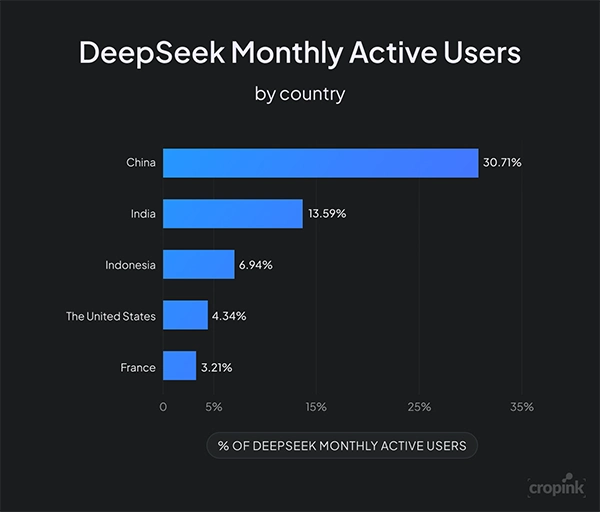Digital innovations have transformed life experiences, work, and connections with others globally. AI has become one of the dominating forces in our lives. You can see how a DeepSeek chatbot is assisting different sectors.
It has significantly outperformed GPT 4o in benchmarks for coding, reasoning, and math. Developed by a Chinese startup, this AI has emerged as a major player in terms of cost and performance.
On top of this, a report stated that in April 2025, this AI site had about 38 million monthly active users. These statistics show that many people out there are looking forward to this.
So are you also excited to try this out? Before that, determine how DeepSeek stands against other major artificial intelligence models in performance and capabilities.
In this article, I will provide a comparative overview and real-world applications to help you gain a deep understanding of it.
KEY TAKEAWAYS
- The MoE architecture ensures high performance with lower computational costs.
- This platform excels in coding, math, and logical reasoning but can be less versatile than rivals.
- It has achieved higher scores than GPT 4o on several key technical benchmarks.
Unlike other models, including GPT and Claude, that use traditional dense transformer design, DeepSeek’s AI approach to us is completely different. Well, I have depicted the detailed overview for better comparison below:
On a standardized test, DeepSeek has shown amazing results. It has scored 90.2% and the MATH-500 benchmark, outperforming Claude and GPT 4o. Additionally, it uses a Mixture-of-experts (MoE) architecture, which works like a team of specialists.
However, this model is still open to adapt more versatility in the range of wind topics.
When a user asks a question, the model, instead of using its entire brain, intelligently activates only the most recent expert to answer the query. For example, a math expert might be activated for a complex calculation while a coding expert can handle a programming task.
No doubt, DeekSeek’s presence with a lot of advantages is powered by its core strengths. But it also comes with some limitations. Let’s understand both of them:
Strength:
Limitation:
Acknowledging both pros and cons help users to utilize the platform effectively and evict negative outcomes.
INTERESTING FACT
DeepSeek AI processes more than 500 million queries every day, along with 90% accuracy in benchmark tests for language understanding. This has helped it become the top artificial intelligence model.

In reality, DeepSeek is making out a niche for itself. For applications where precision and efficiency are paramount, it is becoming the preferred choice.
Many industries are seeking help from it in different forms. Businesses in tech, finance, and retail are starting to use DeepSeek for tasks like data analysis, virtual assistants, and customer service. Imagine it is a powerful automatic debugging assistant for software developers, an autonomous tutor for complex math problems, or an AI chatbot to provide technical support to engineers.
Today, it may not be applicable everywhere as compared to other AI models, but its effective features are still outstanding. In fact, the development team is ready to partner with other parties to add more to it.
DeepSeek is another language model; it is a testament to the power of specialized, efficient architecture. While it may not be the best yet, its superior performance in specific domains makes it effective. Many technicians prefer it more than its competitors due to its efficacy.
Overall, this AI meets every aspect in a new generation of developers and businesses. In fact, the growing adaptability and versatility will make it the go-to platform in the future.
MoE stands for Mixture of Experts, meaning multiple small models are architected together.
It is a more advanced version with more abilities that builds upon the foundation of DeepSeek-V2.
No. While it can interpret Chinese sectors deeply, it accepts English as well.
DeepSeek offers both open-source models, such as DeepSeek-V2, and closed-source APIs. Its commitment to the open-source community, however, has made it a popular choice for many developers.
